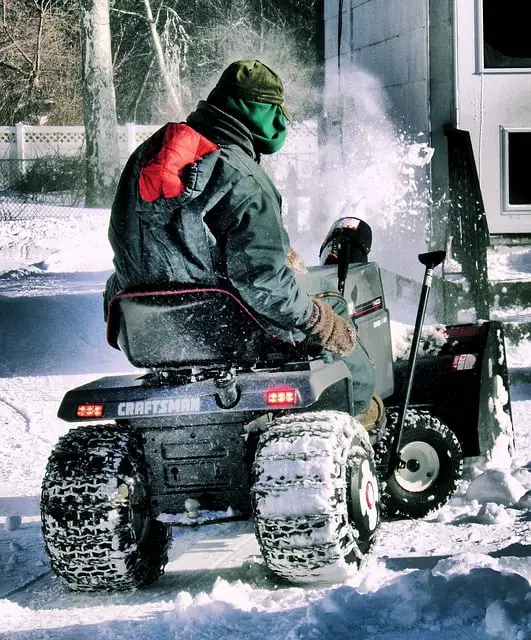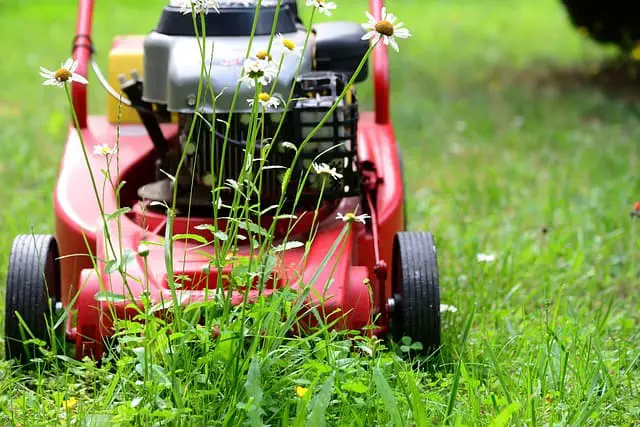The discharge chute on your snowblower is prone to clogging with packed snow and ice. The problem calls for lubricating the chute and other parts of the snowblower. The discharge chute can be lubricated along with the auger and impeller blades using the same lubricants, and there is also another special treatment that will work for only the chute.
I’m a cold-weather fan. It is exhilarating! I’m not a fan of ice and snow. It is treacherous, at worst, and annoying, at best. It annoys me when I try to get rid of the stuff. It defies me by getting clogged in my snowblower. One day, I learned how to be brighter than the snow.
Why Does My Snowblower Clog Up?
The Parts Involved
Three parts of a snowblower get clogged: the auger, the impellor blades, and the snow discharge chute.
The auger looks like a drill bit turned sideways. It rotates as the snowblower moves along, cutting into the snow and pushing it to one side.
In moderate-sized and larger snowblowers, a motor rotates blades that grab the snow and help it along its way into the snow discharge chute. These are the impeller blades. Smaller snowblowers work without them. A powerful fan then blows the snow out of the discharge chute.
The Worst Type Of Snow
When snowfall is loose and dry, a snowblower will pick it up and move it without clogging. Of course, the snow will also blow right back over the places you clear, but that is another annoyance altogether.
Clogging comes into play when snowfall is heavy and wet. As the snowblower moves forward, the auger cuts into the snow and shoves it to the side. However, as it does this, the snow packs together.
The Clogging Process
Remember making snowballs out of heavy snow? Remember how the snowball got harder and harder the more you packed it together? If you kept at it, the snowball would sometimes turn into an ice ball. Your gloves would get wet with the water pressed out of the snow.
Snow does the same thing as a snowblower moves it. It packs together, becoming denser and heavier, squeezing water out. That water freezes on metal parts. The colder the temperature, the quicker it collects.
The auger moves less snow. The impeller blades slow down with the increasing weight of gathering ice. Finally, the discharge chute begins to ice up, narrow, and less snow is able to blow out. Before long, the snowblower is working too hard to move too little snow, and it gives up, stalls, and quits.
Can Clogging Be Prevented?
I had a neighbor who insisted nothing could prevent snow and ice from clogging a snowblower. His answer was to carry around a tank of de-icer. When his snowblower slowed down, he sprayed it with the de-icer and went back to work. I think he spent as much time de-icing his machine as he did blowing snow with it.
I believed him, at first, then I did a bit of research. There had to be a better solution than his! I discovered another solution, liked the idea, and implemented it before the next snowfall. I cleared my property in half the time as it took him.
He paid me a visit after he finished. “New snowblower?” he asked. “Nah,” I replied. “Just changed out parts.” He looked at my snowblower. “Seems to work better,” he said. “What did you do?” I said I found an auger and set of impeller blades made of a new space-age platinum and porcelain alloy that repel ice.
He looked a little closer at my snowblower, frowned, raised up, and grunted, “Huh. Doesn’t look much different than mine.”
What Had I Done?
Later on, we had a good laugh about my prank over a glass of warm brandy. I told him what I had discovered. Something can prevent snow and ice from clogging up a snowblower.
There are several commercial products meant to prevent snow and ice from sticking to metal. DuPont Snow and Ice Repellant, Fluid Film, Other SNO-Jet Snow-Jet Snowblower Spray, and Snow Wax Snow and Ice Repellant Coating are among them. They claim to work well on snowblowers. They also cost $10-$15 a can.
There seemed to be a bit of validity about claims of using WD-40 as an ice preventer. I was skeptical, but since then, I have met several people who use WD-40 as the solution for their clogging problems.
My Secret Solution
What seemed to be the biggest old wives’ tale turned out to be God’s gift to snowblower owners. I laughed, at first, when I uncovered a website that told me to use PAM cooking spray on a snowblower. I stopped laughing as I continued reading. Here was a solution that was simple, cheap, and organic.
PAM is a blend of three oils (palm, coconut, and canola) that provide a lasting waterproof barrier on metal. Coconut and palm oil solidify at temperatures much higher than freezing. At 32°F, they are thick, solid, and wax-like. Canola oil does not solidify until it reaches temperatures below 14°F.
The first step is to get the snowblower parts nice and dry. Sprayed on clean, dry metal, PAM flows over it; the palm and coconut oils fill the pores of the metal and solidify. The canola oil is a thick, sluggish coating on top of them.
PAM contains lecithin. Lecithin is an emulsifier; it allows water and oil to mix. So, the auger pushes snow, packs it together, squeezing water out, and lecithin makes water mix with canola oil, dropping the freezing point of the mix below freezing. PAM creates a barrier on the auger, impeller blades, and chute surfaces, preventing ice from forming. No ice, no contact, no stick, no clog! It just slides off.
My Last Laugh
Remember I told you there was a special treatment that applied only to the discharge chute? I never told my neighbor about it. We were both blowing snow away with no clogging, but my neighbor would still look at my snowblower and wonder. He couldn’t figure out why my paint job and discharge chute looked so much better than his.
I found out I could use ski wax on the body of my snowblower to give it a lasting shine, and because it was super slick and incredibly durable, it was a perfect spray solution for a discharge chute.
I know you can’t blame me for not telling all my secrets.
Hi, I’m John Stephens, chief editor and writer for Totalgardener.com. I’ve been gardening and raising animals for over 15 years starting with a small backyard plot in Northern Virginia where I grew corn, potatoes, squash, and using a high mulch technique called the Ruth Stout Method. I also raised ducks and small mammals for meat and eggs in a movable pen similar to the ones used by Joel Salatin. I later moved to Colorado where I experimented with growing greens using aquaponics inside. I eventually added a microgreens setup and home sprouting operation. I’m excited to share everything I’ve learned plus more from the other local gardening and animal raising experts I know.



